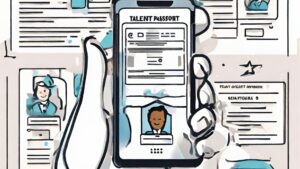Envisioning the Future of LERs: Bridging the Gap for Workers in 2024
Learning and Employment Records (LERs) hold immense potential, but the journey to their full realization is still a work in progress. In this blog post, we’ll delve into the vision of what LERs are intended to be and explore the roadmap toward their evolution. We’ll also emphasize the importance of focusing on practical solutions for workers in 2024, including creating bridge technology for current job posting and applicant tracking systems, as well as tools that pave the way for future upgrades.
The Vision of LERs: A Comprehensive Record of Skills and Achievements
LERs envision a future where individuals possess a comprehensive and dynamic record of their skills, competencies, and achievements. This digital record, controlled by the learners and earners themselves, goes beyond traditional resumes and transcripts. It includes a rich tapestry of learning experiences, from formal education to work-based learning and independent skill acquisition. Key aspects of this vision include:
- Skills-Centric Approach: LERs emphasize skills as the primary currency in the job market. Individuals can highlight their diverse skill sets acquired through various avenues, leveling the playing field for those without traditional degrees.
- Personalized Learning Pathways: LERs enable learners to create personalized learning pathways, identifying skill gaps and accessing relevant educational and training opportunities.
- Efficient Talent Matching: Employers can tap into a broader and more diverse talent pool by using LERs to match applicants with specific skill requirements, leading to more efficient hiring processes.
The Roadmap to LER Realization: Challenges and Progress
The journey toward a fully realized LER ecosystem comes with its challenges and milestones. Progress has been made, but there’s still work to be done. Some key areas to consider on the roadmap include:
- Interoperability: LER systems must be interoperable, allowing seamless sharing and integration of records across various platforms and systems. Progress has been made in standardizing data formats, but true interoperability remains a goal.
- Data Security and Privacy: Ensuring the security and privacy of LER data is paramount. Progress has been made in developing secure standards, but ongoing vigilance is necessary to protect individuals’ sensitive information.
- Equity and Inclusion: LERs aim to address systemic inequities in education and employment. Initiatives have been launched to promote equitable access, but more efforts are needed to ensure inclusivity for all.
Focusing on Practical Solutions for Workers in 2024
In 2024, the LER community needs to prioritize practical solutions that benefit today’s workers. This includes:
- Bridge Technology: Developing technology that bridges the gap between current job posting and applicant tracking systems with the LER ecosystem. This ensures that workers can present their LERs in a format compatible with existing processes while laying the groundwork for future upgrades.
- User-Friendly Tools: Creating user-friendly tools that enable individuals to easily compile, curate, and present their LERs to organizations. These tools should be intuitive and accessible, even for those with limited technical skills.
- Education and Training: Providing resources and training to workers on how to effectively utilize their LERs for job applications, skill development, and career advancement.
In conclusion, the vision of Learning and Employment Records is promising, but we must acknowledge the road ahead. To make LERs a practical reality for workers in 2024, we need to focus on bridging the technology gap, offering user-friendly tools, and ensuring that LERs address the immediate needs of today’s job seekers while laying the groundwork for a more equitable and skills-centric job market in the future.





